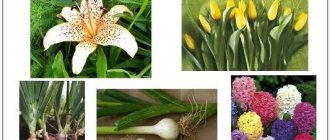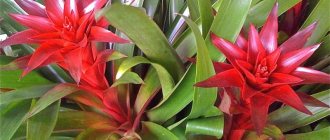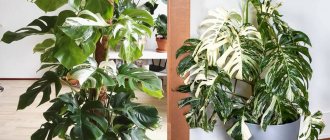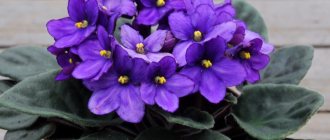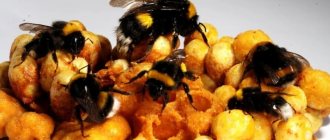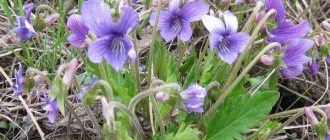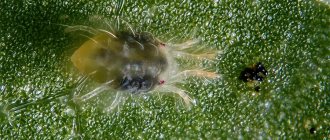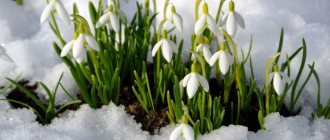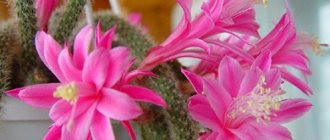Notes
- For the convention of indicating the class of dicotyledons as a superior taxon for the group of plants described in this article, see the section “APG Systems” of the article “Dicotyledons”.
- Information about the genus Ranunculus
Index Nominum Genericorum
database of the International Association for Plant Taxonomy (IAPT). - Flora of the USSR, 1937.
- Barabanov E.I.
Botany: a textbook for students of higher educational institutions. - M.: Publishing House, 2006. - P. 237. - 448 p. — ISBN 5-7695-2656-4. - Andreeva I. I., Rodman L. S.
Botany. — 3rd, revised. and additional - M.: Kolos, 2005. - P. 396. - 528 p. — ISBN 5-9532-0114-1. - Ranunculus
(English). The Plant List. Version 1.1. (2013). Retrieved August 4, 2022.
Barnyard grass (amaranth family)
Larkspur
Umbrella family: characteristics and representatives
When talking about field larkspur, several names are used: horned cornflower, larkspur.
It grows, as a rule, among winter crops, less often among spring crops. Clumps of larkspur can also be found in fallow fields.
The flower is irregular, blue-violet, with spurs. They are located on the stem in the form of a sparse branched brush. The perianth is represented by two colored sepals and two petals. Pollination is cross-pollination, with the participation of insects with long proboscis. With their help, they get nectar from the spur. The stem is branched and can reach a height of 30 cm. The leaves are trifoliate with linear lobes. The fruit is a leaflet. The seeds are dark gray in color and can reach 2-5 mm in length. On the outside they are covered with thin scales. They have a bitter taste and poisonous properties. Cases of larkspur poisoning are common in sheep.
Marsh marigold
Homeland - zones of the northern hemisphere. A perennial plant belonging to shallow-water plants planted to decorate artificial reservoirs. The plant has a low stem, the height of which reaches 20-30 cm, and a powerful rhizome. The shiny basal, long-petioled leaves are kidney-shaped. The flowers are solitary, golden yellow in color and bloom from May to June.
The plant is propagated by dividing the rhizomes. Marsh marigold is a frost-resistant, moisture-loving plant. Grows well in shallow water with fertile clay soil. Marigold marigold is planted in parks, in damp areas, near shallow artificial reservoirs, and along the banks of streams. Two types of this plant are known: perennial marigold, thin-leaved marigold.
Ranunculaceae family
The Ranunculaceae family includes dicotyledonous, free-petalled flowering plants. This group of plants includes approximately 50 genera and more than two thousand plant species, which grow mainly in areas with temperate and cold climates on all continents of the Earth. Ranunculaceae are found in the extratropical zone of the Northern Hemisphere. In the tropics and subtropics, plants of this family grow only in high mountain areas
The Ranunculaceae family occupies an important place in the flora of the Arctic, despite the fact that the number of species here is small (about 13 genera).
Representatives of the buttercup family are herbaceous plants; they can be annual, biennial or perennial. Rare species are subshrubs or climbing shrubs, for example, plants of the genus Clematis.
The vast majority of species of the ranunculaceae family require sufficient, sometimes excessive, moisture
In some cases, good moisture is only necessary at the beginning of the growing season. An essential factor for the survival of buttercups in the far north is reliable protection in winter by snow cover. Among the buttercups there are aquatic plants.
Characteristics of the ranunculaceae family are given below. In most plants of this group, the root system is represented by rhizomes; stolons can form; there are thickened roots in which nutrients are stored. The stem is herbaceous, the woody structure is characteristic exclusively of the genus Clematis.
Ranunculaceae leaves can be simple (whole) or complex (palmate, pinnately dissected) in different species. Stipules are absent. The arrangement of leaves is alternate, only in species of the genus Clematis it is opposite. Some species have only basal leaves, while others, in addition to them, also have stem leaves.
Flowers of the Ranunculaceae family are bisexual, less often unisexual, regular (with perianth). They are collected in inflorescences - brushes or panicles; sometimes the flowers are located singly at the top of the stem or in the axils of the leaves. A typical Ranunculaceae flower has characteristic features. The corolla has five petals, five sepals, numerous stamens and pistils arranged in a spiral on the receptacle. Flowers of some species exhibit deviations from the typical structure. Petals can be modified, variations in the number of stamens, pistils, and sepals are possible. The color of the flower corollas is varied - yellow, red, blue, white. Pollination of flowers of most species is carried out by insects, which are attracted to them by nectar.
The fruit of buttercups is a composite, consisting of multi-seeded leaflets or achenes. In rare species the fruit is a capsule or berry. In the seed, the protein occupies a larger proportion, and the embryo occupies a smaller proportion. The fruits are carried by wind, water, and animals.
The importance of plants from the buttercup family in the natural environment and human life is very great. Many of them are medicinal plants, for example, adonis, basilisk, sleep grass, hellebore. This is due to the fact that different active substances are found in different parts of plants. Aboveground shoots and leaves of buttercups contain various flavonoids, and in lower concentrations – essential oils, saponins, resins, and tannins. The seeds are rich in fatty oils. Ranunculus plants from one group contain anemolol, from another - cardenolides, from the third - alkaloids. Most buttercup plants are poisonous to animals and humans.
Many ranunculus plants are ornamental due to their brightly colored flower corollas, for example, leotard, coppice, larkspur, anemone, clematis, etc. These species are cultivated by humans.
Spreading
Ranunculaceae is a large family containing from 1200 to 1500 [3], according to other sources over 2000 [4] species.
They are found mainly in the extratropical regions of the Northern Hemisphere, up to and including the Arctic region. A fairly significant number of representatives are found in the tropical zone, but mainly in high mountain regions, as well as in extratropical regions of the Southern Hemisphere. In the Arctic, the family is represented by 13 genera. In terms of the number of species, it occupies a prominent position in its flora.
The bulk of the species in the family are plants associated with conditions of sufficient and partly excessive moisture or excess moisture at the beginning of the growing season. There are also aquatic plants among them. A prerequisite for the existence of buttercups in the Arctic is sufficient protection by snow cover in winter.
Advantages
It is worth noting that buttercups have many useful properties and advantages compared to other ornamental flowering plants.
- Medicinal properties. Many types of buttercups are used in folk medicine. On their basis, tinctures and ointments are prepared, and the juice of the plant is also used for medicinal purposes.
- Resistance to diseases and pests. Of all the known misfortunes, buttercups are susceptible to powdery mildew. But this rarely happens, since buttercups are accustomed to dampness and react to waterlogged soils very tolerantly.
- Easy to care for. If you decide to plant a buttercup in your summer cottage, then you don’t need to worry whether your care will be enough for it.
- Easily propagated. It is enough to simply grow at home from seeds or tubers. And in the wild, seeds are carried by the wind over long distances.
Thus, the Ranunculaceae family is extremely diverse. It sometimes includes plants that are diametrically opposed in their qualities.
Forest anemone
Homeland - Europe, Ciscaucasia, Siberia and the Far East. Forest anemone belongs to the group of plants used to decorate ponds, as well as to ground-blooded plants that serve as lawn decorations.
These are perennial herbaceous plants of the buttercup family with a powerful rhizome and tubers with erect transparent, leafless stems, the height of which is 20-80 cm. The leaves are large, pinnately dissected, collected in basal rosettes. The fragrant flowers are small, single or collected in multi-flowered semi-umbrellas of white, red, yellow, pink, bluish-violet.
Forest anemone blooms in June for a month. The fruit is a leaflet. Anemone is propagated both by seeds and by dividing rhizomes. The plant is frost-resistant, easily tolerates winter, without shelter. It also grows well in partial shade. The soil needs to be light, sandy, enriched with lime, moderately moist.
It is observed that the plant can grow in one place for up to 4-5 years. Forest anemone is planted in parks, mixborders, in damp areas, in groups. Varieties: Crown anemone, Japanese anemone, Canadian anemone, Oak anemone, Caucasian anemone.
Seed propagation of perennials of the ranunculaceae family
The seed method of propagation of these perennials is used less frequently than the vegetative method, since with this method of propagation the plant develops more slowly. However, such perennials as Borets, European Bathwort, Asian Bathwort, Knyazhik, Noble liverwort, small-flowered Clematis, Cohosh, Black cohosh, Adonis, Basil, Hellebore, Wintergreen - also reproduce in this way.
Their seeds are sown in autumn in pots or boxes with well-prepared loose soil to a depth of 1-2 cm, and placed in greenhouses. In the spring of next year, the seedlings are transplanted into well-prepared, open, wind-protected ridges.
The plant begins to bloom in the second year after sowing. Prince and Adonis begin to bloom only 3-4 years after sowing. It should be especially noted that the seeds of such perennials as Fighter, European Swimsuit, Asian Swimmingweed, Prince, Noble liverwort, Vesennik, Erandus, Lumbago, Sleep-grass, must be sown in prepared boxes or pots immediately after collecting them, because they are quickly lost germination.
When and where to plant buttercups in open ground
Already at the end of winter it is worth taking care of purchasing planting material. Until the beginning of April, it is recommended to store the tubers in a cool (no more than seventeen degrees Celsius) but well-ventilated area. It is advisable to plant the plant (for seedlings) in an individual pot or peat tablet, since buttercups do not tolerate transplantation well.
You can plant the tubers immediately in open ground, but you need to do this a little later, around the second half of May
At this time, warm weather is already setting in, which is very important for garden buttercups, since they are heat-loving plants and will not tolerate low night temperatures
The place for planting flowers should be in partial shade, preferably not in a draft or in an open area. The plant does not like strong gusts of wind. The site may be located near a low tree or bush. In an open space under direct sunlight, the decorative qualities of the buttercup will suffer. Its flowering will be short-lived and not abundant.
Neighborhood with other plants and flowers
Garden buttercup goes well in a flowerbed with various plants. Its color scheme allows it to be a self-sufficient flower, but in combination with flowering plants in blue and light blue it looks even more gorgeous.
Experienced gardeners advise paying attention to the “aggressiveness” of the plant’s root system. It can grow very quickly and can harm neighboring crops by occupying their territory
Soil composition requirements
Before planting tubers in open ground, it is recommended to take care of its nutritional content. Use humus as fertilizer. The acidity of the soil should be neutral, and the soil itself should be loose and light.
Rules for planting buttercups
The tubers of the plant, which have been stored in a cool room for approximately 1-1.5 months, now need to be soaked in a weak pink solution of potassium permanganate or in a growth accelerator. Within twelve hours, the planting material will be saturated with the required amount of moisture, and the roots will swell slightly.
On a prepared plot of land, you can prepare small holes in advance at a distance of about 20 centimeters from each other. Plant one tuber (roots down) in each hole to a depth of 4-5 centimeters. In about a couple of weeks the first shoots will appear.
In case of unfavorable weather forecasts and the threat of cold weather, it is better to insulate the beds with plants.
Childbirth
The family includes about 60 genera and 1700–2500 species (probable encompassing taxa are indicated in parentheses).
- Aconitum L. - Fighter, or Aconite
- Actaea L. - Voronets
- Adonis L. - Adonis
- Anemoclema (French.) WTWang
- Anemonastrum Holub
- Anemone L. - Anemone, or Anemone
- Anemonella Spach (Thalictrum)
- Anemoneoides Mill. — Anemone, or Windwort, or Anemone
- Anemonopsis Siebold & Zucc. — Anemonopsis
- Aquilegia L. - Catchment, or Aquilegia
- Arcteranthis Greene
- Asteropyrum JRDrumm. & Hutch.
- Batrachium (DC.) Gray - Mulberry (Ranunculus)
- Beckwithia Jeps. (Ranunculus)
- Beesia Balf.f. & WWSm.
- Calathodes Hook.f. & Thomson
- Callianthemoides Tamura
- Callianthemum CAMey. — Callianthemum, or Beautiful Flower, or Rutovnik
- Caltha L. – Marigold
- Ceratocephala Moench - Horncap (Ranunculus)
- Cimicifuga Wernisch. — Black cohosh, or black cohosh (Actaea)
- Clematis L. - Clematis, or Clematis
- Consolida Gray - Sokirki, or Consolida (Delphinium)
- Coptidium (Prantl) Rydb. — Arctolutik (Ranunculus)
- Coptis Salisb. — Coptis
- Cyrtorhyncha Nutt.
- Delphinium Tourn. ex L. - Larkspur, or Delphinium, or Spur
- Dichocarpum WTWang & PKHsiao
- Enemion Raf. — Enemion
- Eranthis Salisb. — Vesennik, or Erantis
- Eriocapitella Nakai (Anemone)
- Ficaria Guett. — Chistyak (Ranunculus)
- Glaucidium Siebold & Zucc. — Glaucidium
- Gymnaconitum (Stapf) Wei Wang & ZDChen (Delphinium)
- Halerpestes Greene - Slider
- Hamadryas Comm. ex Juss.
- Helleborus Tourn. ex L. - Hellebore, or Helleborus
- Hepatica Mill. — Liverwort
- Hydrastis J.Ellis ex L. - Goldenseal, or Hydrastis
- Isopyrum L.
- Kingdonia Balf.f. & WWSm. (Circaeastraceae)
- Knowltonia Salisb.
- Krapfia DC. (Ranunculus)
- Kumlienia Greene (Ranunculus)
- Laccopetalum Ulbr. (Ranunculus)
- Leptopyrum Rchb. — Leptopyrum
- Leucocoma (Greene) Nieuwl. (Thalictrum)
- Megaleranthis Ohwi (Trollius)
- Metanemone WTWang
- Miyakea Miyabe & Tatew. — Miyakeya (Pulsatilla)
- Myosurus L. - Mousetail (Ranunculus)
- Naravelia Adans. (Clematis)
- Nigella L. - Nigella, or Nigella
- Oreithales Schltdl. (Knowltonia)
- Oxygraphis Bunge
- Paraquilegia JRDrumm. & Hutch. — False water collection
- Paroxygraphis WWSm.
- Peltocalathos Tamura
- Pseudodelphinium H.Duman, Vural, Aytaç & Adigüzel (Delphinium)
- Pulsatilla Mill. — Backache
- Ranunculus L. - Buttercup
- Semiaquilegia Makino - Semi-catchment
- Souliea Franch. (Actaea)
- Thalictrum Tourn. ex L. - Basil
- Trautvetteria Fisch. & CAMey.
- Trollius L. – Swimsuit
- Urophysa Ulbr.
- Xanthorhiza Marshall
Cactus in a pot
Very often people plant these plants in pots and place them on the windowsill, so let's take a pencil and draw a cactus in a pot.
So, let's draw three cacti in pots with a pencil. Each of them is an inverted pyramid with almost vertical edges. The upper part of the pot should be depicted as an elongated rectangle. Then we will depict three cacti. The first is in the form of many standing nearby, highly elongated oval-shaped objects. The second is in the form of a zucchini, adding shoots to it that look like ovals, curved upward. The third is in the form of a semicircle, inside of which there are vertical grooves. At its top, simple oval lines indicate the contours of the flower.
Color the entire drawing. This can be done using watercolor paints or colored pencils. When working with watercolors, you need to be careful when painting the edges, as this paint can bleed.
With a little imagination and using the method described above, you can get drawings like these.
Lumbago, Dream-grass
Distributed in areas of the Northern Hemisphere. Herbaceous perennial, has vertically long or obliquely located rhizomes. The basal leaves are openwork, palmately dissected or palmately dissected - in rosettes, stem leaves - in whorls that form the involucre of the flowers. Ranunculus flower is single, bell-shaped, of various colors: purple, pink, yellow, white, lilac. The plant blooms in April-May.
Propagated by seeds. The plant begins to bloom 2-3 years after sowing. Lumbago is a semi-shade-tolerant, frost-resistant plant; to grow it, the soil must be fertile, drained and moderately moist. The plant is planted in mixborders, alpine and rocky gardens. The following types are known: Large lumbago, Crimean lumbago, open lumbago, mountain lumbago, ordinary lumbago.
The most popular ranunculus plants
This genus includes up to three hundred species. The most common of them are the following.
Buttercup caustic
Buttercup caustic
This is a meadow and field plant, the most typical representative of the genus.
It is considered a weed, and gardeners and summer residents no longer know how to get rid of it.
It reaches a height of 20-50 cm. The leaves are segmented, with five palmate segments. Attached to the stem with long cuttings. Ranunculus blooms in spring. The flowers are located at the top of the stem and are bright yellow in color. Stipules are green.
It is considered poisonous and can cause poisoning in livestock.
Larkspur
It is also called horned cornflower. Larkspur has a branched stem up to 30 cm high. The leaves are dissected and trifoliate.
Larkspur
The flowers are irregular, blue or purple in color. These flowers are cross-pollinated with the help of insects. The fruits are poisonous, the seeds are dark gray and small.
This representative lives in crop fields, both winter and field. Also found in fallow fields. Due to its toxicity, it is dangerous for livestock. Sheep are particularly affected by it.
Lumbago
Unlike its brother, caustic buttercup, lumbago is very rare. In Siberia, the population of this species is still large, but in many countries, for example, in India, it is listed in the Red Book.
This type of buttercup is also called snowdrop. It blooms in early spring, literally from under the snow. First, a flower appears on a short petiole. Then the stem stretches and leaves appear. The flower of the lumbago is regular, glass-shaped, purple in color. It became widespread in meadows and gentle slopes of mountains.
Lumbago
Aconite
The second name of this plant is “monk’s hood.” This is explained by the special structure of the aconite flower. It is irregular, and one petal is much larger than the others, looking like a helmet.
The color of flowers varies in different regions: in the steppe - yellow, in the taiga - purple and blue.
Aconite reaches a height of 2-3 meters, the stems branch. It strangles the neighboring ones, growing in breadth. Both the above-ground part and the tubers are poisonous. The latter are used by hunters instead of curare.
Leaves and shoots are dangerous for all representatives of the animal world, except for one rodent - the pika. They make provisions for the winter by cutting off the stems of aconite at the root.
Adonis
Natural habitat is steppes. Therefore, the height is small - up to half a meter. The leaves are thin, thread-like. The flower is large, bright golden in color.
Adonis has healing properties.
Widely used in traditional medicine, as part of heart drops. Unfortunately, the population of this plant is currently declining; the remaining areas of distribution of adonis are protected.
Hellebore
This species has become widespread in Europe; its varieties are especially diverse in the Balkans. Preferred places of growth are shady mountain slopes. The plant is not tall.
Leaves on long petioles, palmate. The flowers are large, white, greenish or pinkish. Flowering occurs in spring.
Parts of the plant are poisonous. In medicine it is used for heart diseases.
Anemone
It got its name due to its sensitivity to wind. Even with minor impulses, the plant begins to bend.
It grows in central Russia, in forests, mountain valleys, and shady meadows. The stems of anemone are elongated, the leaves are dissected, palmate, on long petioles.
The flowers are semi-umbrella, large, regular. Flower colors are white, blue, green, yellow, orange, red.
Plants and all its parts are poisonous. Anemone
5.Home care or forcing
For growing at home, dry rhizomes of Asian buttercup are most often used. With the help of forcing, you can get a flowering plant for any holiday. From planting the rhizomes to the appearance of the first buds, it takes about 12 - 15 weeks.
For planting, select a small flower pot, on the bottom of which a drainage layer of expanded clay or broken brick is placed. Fill the container with flower soil and lightly moisten it. The rhizomes are placed with the shoots down and buried to a depth of about 3 cm. The surface of the soil can be compacted a little and sprayed again.
The frequency of watering should correspond to the degree of development of the ground green mass - the more leaves, the more often it is worth watering the flower. The first waterings should be scanty. Reduce watering after flowering and as the leaves die.
Water the plants with well-settled tap water or rain and spring water, warmed to room temperature. Excess moisture that appears in the pan after watering is drained after a few minutes. You should not water the buttercup during the day if it is in direct sunlight.
The location should be a south, south-west or south-east window sill, where there is a sufficient amount of light. When grown in the shade, the plants will become elongated and bloom reluctantly.
If there is insufficient natural light - for example, if the rhizomes were planted in the winter months, use artificial lighting in the form of LED or fluorescent lamps. With the help of such additional lighting, the duration of daylight hours is increased to 12 - 14 hours a day. At night the lights are turned off.
It is best to maintain the air temperature in the room at 15 - 18 degrees Celsius, trying to prevent the plants from overheating. Good ventilation is also a prerequisite - the room should be ventilated periodically. If ventilation occurs in the winter months, then the flower pot is taken to another room.
From time to time it is also worth spraying the plants without getting on the flowers and buds. Instead of spraying, you can use a pot tray filled with wet gravel. At elevated temperatures, the tips of the leaves will dry out, and the buds may fall off without blooming.
The first feeding is carried out a few weeks after planting - when the leaves appear. Any composition with a high content of potassium and phosphorus can be used as fertilizers - they will promote abundant and long-lasting flowering.
Feed the flower 2-3 times a month until it blooms. As one of the last feedings, you can offer potassium fertilizers to ranunculus - they will help maintain the health of the bulb before the onset of the dormant period.
After flowering, the plants are gradually transferred to a dormant state - they lower the temperature and dry out the soil in the pot more and more, reducing watering. After the above-ground part of the bulb dies, it can be removed from the soil and dried, and then sent for storage.
For storage, select a cool and dry place with an air temperature of 15 - 17 degrees Celsius. Since the bulbs must breathe during the process, they are stored in canvas bags or paper bags. To maintain an optimal level of moisture, the bulbs can be sprinkled with barely damp river sand, tree sawdust or peat.
Every week, planting material is taken out and inspected for the presence of rot and diseases - the affected rhizomes are discarded. If the damage is minor, you can try cutting off the rotten part of the tuber and treating the cut with antifungal drugs or regular brilliant green.
Not all rhizomes successfully survive wintering indoors. Rhizomes should be handled carefully, as dry root shoots break easily. Unfortunately, the most abundant flowering of ranunculus occurs in the first 2 - 3 years of life, then it declines.
Clematis
Homeland - temperate zone of the northern hemisphere. The genus of these most ornamental plants of all known woody vines, representatives of Ranunculaceae, has various forms - these are shrubs and subshrubs with both climbing shoots from 1.5 to 10 m high, and straight (up to 1.5 m) herbaceous perennials with straight shoots , whose height is from 30 cm to 1.5 m.
The leaves are entire, trifoliate or odd-pinnate. Flowers from 1 to 20 cm high, petalless, saucer-shaped, wide-bell-shaped, tubular, cup-shaped. Collected in inflorescences, sometimes single flowers are found. The sepals are petal-shaped, of various colors - white, yellow, blue, purple, carmine-red with various numerous shades.
Flowering is observed in June-July. The fruit is an achene with a pinnately pubescent nose; the seed ripening time is September-October. Clematis is propagated by seeds, green cuttings, and dividing the bush. The plant is light-loving, however, in the southern regions it is necessary to create light shading, and in the northern regions it is necessary to protect it from the wind. The soil for its cultivation should be moderately moist, fertile, permeable, neutral or slightly alkaline.
Bush forms of clematis are planted in borders, vines are used for vertical gardening.
Of the many varieties of clematis, there are:
Clematis large-flowered, clematis small-flowered.
Clematis grandiflora Jacquemman is a hybrid that was obtained in 1860 by Jacquemman as a result of crossing Clematis violet with Clematis woolly; these buttercup representatives look like a hybrid vine, the height of which reaches 4 m. The leaves are dense, odd-pinnate, dark green in color, consist of 3-5 leaves. Velvety, wide-open, odorless flowers, up to 15 cm in diameter, violet-blue. There are 4 – less often – 5-6 sepals. Flowering is observed from June until frost.
The fruit is a large, rounded achene, up to 8 cm in diameter, with a long feathery nose. Propagated vegetatively by green cuttings. Clematis grandiflora Jacquemand is common for vertical gardening in the southern and northern regions of Russia.
Using this hybrid, numerous varieties of Clematis have been bred, which are united in a group called the Jacqueman group:
- Victoria - purple-pink flowers;
- Mephistopheles - velvety dark purple flowers;
- Sputnik - flowers are gray-blue;
- Ville de Lyon - purple-carbine-red flowers;
- Crimson Star - flowers are dark dirty red with a purple tint;
- Violet-double - pink-violet flowers;
- Ernest Markham - deep crimson flowers;
- Gypsy Queen - dark purple flowers - is the most beautiful of all the varieties in this group.
Small-flowered Clematis are vines whose length reaches 4 m. Flowers with a diameter of 2.5 to 5 cm are collected in inflorescences of various colors depending on the variety of clematis. Flowering occurs in June-July; small-flowered clematis is propagated only by seeds. The following varieties are known:
- Armande is an evergreen vine;
- Clematis violet - flowers purple, violet, blue, lilac;
- Oriental clematis - yellow or yellowish flowers;
- Clematis stinging - flowers are white, fragrant;
- Grape-leaved clematis – white, small flowers;
- Clematis paniculata - white, fragrant flowers;
- Clematis balearica is an evergreen graceful vine, the flowers are bluish-white with purple speckles.
Clematis are the most preferred varieties of ornamental perennials by gardeners in the southern regions; they are very popular when decorating parks, squares and personal plots in the southern regions. In our area, it is called “Warthog” and is used moderately often.
4.Reproduction
There are several methods of propagation for buttercups: dividing bulbs, forming air layering and seeds. During generative or seed propagation, plant varietal characteristics may be lost.
4.1.Growing from seeds
Most varieties can be propagated by seeds, however, with this method of propagation in varietal plants, daughter bushes may differ in appearance from their parents. The germination rate of planting material is often low even with proper storage and sometimes does not exceed 20 percent.
It is preferable to buy seeds from a flower shop, but you can also get your own planting material. In order to obtain high-quality seeds, even during the flowering period, you can mark the largest brightly colored buds with colored threads.
The achenes are separated from the mother plants after full ripening. To prevent the seeds from spilling onto the surface of the ground on their own, the achenes are first tied with gauze or a bandage or covered with a nylon sock.
As they ripen, the achenes are cut off and the seeds are sent to dry in a warm and well-ventilated place. Dried planting material is collected in paper envelopes and stored in a cool and dry room.
Sowing of seeds is carried out at home in late February - early March or sown in open ground in May. To grow seedlings, prepare small flower boxes with drainage holes and nutritious and loose soil. The soil mixture can be made up of equal parts of peat and river sand.
The surface of the soil is slightly compacted and moistened with warm water from a spray bottle. The seeds are sown and covered on top with sifted airy soil or a small layer of river sand 4-5 mm thick. The crops are re-moistened and covered on top with glass or a transparent plastic cap to create a greenhouse effect.
The plants are ventilated daily by lifting the cap for a few minutes. The air temperature for germination should be 10 - 12 degrees Celsius. With the appearance of sprouts (usually this happens within 2 - 3 weeks), the air temperature is raised to normal room temperature.
The ventilation time is gradually increased, and with the appearance of the first shoots, the shelter is completely removed.
The bushes develop quite quickly and at the age of 6 - 8 weeks they can show 3 - 4 true leaf blades. The seedlings are kept at room temperature, in a well-lit place, but not exposed to direct sun. The soil is kept evenly moist.
With the appearance of the first true leaves, a dive is carried out - the flowers are planted in separate cups. A week after picking, buttercups can be fed for the first time with nitrogen fertilizers in a very low concentration.
Diving can be done in peat pots - in this case, the seedlings can be transplanted into the garden directly into them. When each plant can boast 3 true leaf blades and reaches a height of 10 cm, the seedlings can be planted in open ground.
Seed propagation helps to obtain many plants at once, but requires a lot of patience - not all varieties of buttercup will form buds in the first year of life. Most often, during spring and summer, the bushes will build up green mass and underground bulbs, and the first flowers will decorate them only in the second year.
4.2. Division of tubers
Before planting, especially large rhizomes can be carefully divided into 2-3 parts by hand. You should not divide the tubers into a large number of parts - even in the best case, the plants will take a long time to recover and will bloom only in the second year; in the worst case, they will simply die.
Places where the wound surface has formed are sprinkled with crushed charcoal or ash and dried
Water such plants after planting with extreme caution, as excess moisture can cause rot. Several daughter bulbs may appear on adult rhizomes during the season - they are separated and planted.
Buttercup caustic
This genus essentially makes up almost the entire Ranunculaceae family. Representatives of the genus are very numerous - more than 300 species
The golden corollas glisten in the sun, as if smeared with butter, which attracts the attention of numerous meadow inhabitants. Despite their external beauty, most buttercups are weeds
Moreover, they are very resilient. In the fight against them, meadow farmers are an obvious loser. These plants demonstrate incredible resilience and adaptability to environmental conditions. For example, in the Faroe Islands, where there is constant heavy rain, the buttercup has adapted to pollination without the participation of insects. Their absence there did not become an obstacle to the widespread distribution of these plants.
It is a meadow weed that blooms in spring. Can be found in meadows until late autumn. The height of the shoots can vary greatly; it varies from 20 cm to 60 cm.
The most typical representative of the family is the caustic buttercup. Although the plant family is very diverse, this species is closest, from an evolutionary point of view, to its ancient ancestors.
The leaves are deeply palmate, five-parted, and have rhombic lobes. The lower ones are attached to long petioles, and the upper ones to short ones.
One of the most dangerous plants for livestock is the caustic buttercup. The family includes other poisonous species, but due to the widespread distribution of the caustic buttercup, it is this plant that most often causes poisoning of domestic animals.
Adonis
The healing herb of the buttercup family is adonis. He very subtly adapts to the conditions of the surrounding reality, sensitively reacting to any disturbances in nature introduced by man. Adonis is a resident of the steppes, which causes the plants to be small in height (no more than 50 cm). The leaves are typical for the habitat - with narrow lobes, almost thread-like, like those of a carrot. The flower is lush, golden in color. The number of petals varies from 15 to 20 pieces, there are many stamens and pistils. Flowers are used in pharmacology. They serve as raw materials for the production of heart drops. But the steppes are being plowed up, and the number of adonis is decreasing. They tried to grow it in the garden, but, alas, it did not take root there. Therefore, areas of the steppe where adonis has survived must be carefully protected.
Characteristics of the Ranunculaceae family would be incomplete without an indication of its diversity. The number of genera in this family reaches fifty, and the species - more than 2000. These are mainly herbs, in rare cases - subshrubs. The woody structure (secondary) is characteristic of only a few species.
Ranunculaceae family: general characteristics, representatives – Gardener
The main characteristics of plants of the buttercup family relate to external characteristics and structural features of organs. In particular, perennial herbaceous plants with alternate leaves without stipules predominate among the representatives.
The buttercup family belongs to flowers, that is, flowering plants. The flowers are usually regular and bisexual. Flowers of the quintuple type are most common, but there are cases of deviations in the number of sepals and petals. Characterized by a large number of stamens and pistils.
https://www..com/watch?v=ytcreatorsru
The receptacle is connected to the stamens and perianth under the pistil. The fastening is free. The corolla-shaped perianth can be double or simple; sometimes the petals can turn into nectaries.
The buttercup family is characterized by cross-pollination. Self-pollination is a rare phenomenon. Fruit type: achene or leaflet.
Spreading
Buttercups grow almost everywhere. Meadows, fields, forests - all these are habitats for representatives of the family. Many buttercups have poisonous properties. They can harm the digestive and circulatory systems of both humans and animals. Characteristic signs of poisoning are vomiting, loose stools, colic, convulsions, and slow pulse.
The buttercup genus is the most numerous
This genus essentially makes up almost the entire Ranunculaceae family. Representatives of the genus are very numerous - more than 300 species
The golden corollas glisten in the sun, as if smeared with butter, which attracts the attention of numerous meadow inhabitants. Despite their external beauty, most buttercups are weeds
Moreover, they are very resilient. In the fight against them, meadow farmers are an obvious loser. These plants demonstrate incredible resilience and adaptability to environmental conditions.
For example, in the Faroe Islands, where there is constant heavy rain, the buttercup has adapted to pollination without the participation of insects.
It is not difficult to answer the question about the morphological classification of the buttercup genus. What family it belongs to can be understood by its name. In colloquial speech, this name is used for many plants, even those belonging to other genera, but having typical characteristics of the family.
We suggest you familiarize yourself with what herbs are perennial
It is a meadow weed that blooms in spring. Can be found in meadows until late autumn. The height of the shoots can vary greatly; it varies from 20 cm to 60 cm.
The most typical representative of the family is the caustic buttercup. Although the plant family is very diverse, this species is closest, from an evolutionary point of view, to its ancient ancestors.
The leaves are deeply palmate, five-parted, and have rhombic lobes. The lower ones are attached to long petioles, and the upper ones to short ones.
One of the most dangerous plants for livestock is the caustic buttercup. The family includes other poisonous species, but due to the widespread distribution of the caustic buttercup, it is this plant that most often causes poisoning of domestic animals.
The cross needs protection
In many European countries, lumbago has become so rare that its ecological value can be compared to that of the tiger in India. The lumbago is included in the Red Book there. There is still quite a lot of lumbago in Siberia. To keep its numbers at a high level, ecologists studied its demography.
The age of each plant within the experimental group was calculated, and subgroups of young and old were identified. The results of the study were very disappointing. The predominance of old individuals over young ones was prevalent. The explanation for this fact can be very different. Perhaps the reason for this is the small number of pollinating insects in early spring.
The lumbago flower is correct. That is, when you cut it into two parts, you always get two symmetrical halves.
The mystery of the proximity of lumbago and pine
The buttercup family, and in particular the genus lumbago, became the object of study for geobotanist I. Ilyinskaya. She successfully unraveled the secret of the constant proximity of the lumbago to the pine tree.
It turns out that the fragile snowdrop is the protector of the tall pine. I. Ilyinskaya conducted her research in the forest-steppe.
From tall trees, pine seeds are carried by the wind to the steppe zone, where it is very difficult for them to take root.
They escaped both the sun's rays and the onslaught of grass. And they were helped by the lumbago bushes, which, like a miniature palm grove, formed the shade so necessary for the young pine shoots. Having strengthened, the pine tree outgrows its defender.
This is how pine trees are gradually replacing the virgin steppe.
The mystery of the proximity of lumbago and pine
The buttercup family, and in particular the genus lumbago, became the object of study for geobotanist I. Ilyinskaya. She successfully unraveled the secret of the constant proximity of the lumbago to the pine tree. It turns out that the fragile snowdrop is the protector of the tall pine. I. Ilyinskaya conducted her research in the forest-steppe. From tall trees, pine seeds are carried by the wind to the steppe zone, where it is very difficult for them to take root. Most young seedlings die from the burning sun and the onslaught of steppe herbaceous vegetation. But there are unusual areas in the steppe where young pines stand out in the middle of the bare steppe. They escaped both the sun's rays and the onslaught of grass. And they were helped by the lumbago bushes, which, like a miniature palm grove, formed the shade so necessary for the young pine shoots. Having strengthened, the pine tree outgrows its defender. This is how pine trees are gradually replacing the virgin steppe.
Aconite
Monkshood flowers are irregular. One of the petals has grown so much that it has become much larger than the rest. It is like a helmet, which is why in some countries it is called the “monk’s hood.” There are 60 species in the genus Aconite. All of them are plants of the northern hemisphere. The buttercup family is known to be characterized by brightly colored flowers. Aconite is another confirmation of this. In the steppe the characteristic color is yellow, in the taiga - blue and purple. The height of the shoots in humid midlands, where the soil does not freeze due to the large amount of snow, can reach 2-3 meters. Then you can only look at it from the bottom up. Aconite thickets, like a dense spruce forest, are dark and damp. This darkness does not allow other plants to develop. The soil is covered with fallen aconite leaves. The stem ends at the top with a huge brush-garland of helmet-shaped flowers: below they are large, blossoming, and above there are more buds. Reliability of procreation is ensured by different times of seed maturation.
The beauty of aconite has long been appreciated in gardening. Hunters in the Himalayas use poisonous aconite tubers, replacing them with curare. The above-ground part is also poisonous, so you should not leave a large bouquet indoors for a long time. The presence of poison in plants guarantees their safety and protects them from being eaten by herbivores. But there is an exception among representatives of the fauna. The pika (a rodent similar to a gopher) loves to feast on aconite greens. In the summer, pikas cut off aconite stems to the very roots, like lumberjacks cutting down trees. These are their winter preparations. Pikas chew the stems, which are then used to make sheaves.
Prince
The plant is common in forest areas of the northern hemisphere. This is a perennial liana that has multiple characteristics of the ranunculus family, thin shoots whose height reaches three meters. The leaves are opposite, trifoliate, dark green in color, have long, pubescent petioles, using which the vine can climb thin supports, tenaciously entwining them.
The flowers are large, up to 8 cm in diameter, solitary, broadly bell-shaped, located on last year's stems. There are 6-8 sepals of white, yellowish, blue-purple or violet color, the number of which is equal to the number of petals of the flower. Flowers and sepals have the same color.
The fruit is an achene, a long, pinnately pubescent column. Flowering is observed in April-May. Knyazhik propagates by seeds, dividing the bush, and cuttings. Knyazhik is a frost-resistant plant, not demanding on soil. Used in decorative floriculture as an early flowering plant.
Habitat
In terms of its distribution, this family covers a variety of natural objects with different climatic conditions.
Most plants are adapted for life in temperate climates.
These species are also moisture-loving; there are specimens growing in water bodies. But there are also species growing in deserts and semi-deserts.
In our country you can find buttercups everywhere. They are common in Asia, the Caucasus, and Siberia. In Europe, you can see representatives of the family in the Alpine mountains. Unfavorable conditions for their growth are only in the far north and hot south.
The cross needs protection
In many European countries, lumbago has become so rare that its ecological value can be compared to that of the tiger in India. The lumbago is included in the Red Book there. There is still quite a lot of lumbago in Siberia. To keep its numbers at a high level, ecologists studied its demography. The age of each plant within the experimental group was calculated, and subgroups of young and old were identified. The results of the study were very disappointing. The predominance of old individuals over young ones was prevalent. The explanation for this fact can be very different. Perhaps the reason for this is the small number of pollinating insects in early spring. As a result, the flowers are poorly pollinated, which is why the number of fruitlets decreases. According to another version, the red background of last year’s grass does not create a very rosy picture, but the purple inclusions of lumbago flowers apparently please the eyes of the townspeople so much that they want to take a piece of this joy home. The lucky feature of the late formation of leaves prevents the “decapitated plants” from dying, but they no longer form fruits. Thus, there is no replenishment of the ranks of young animals. The number of old plants increases.
The lumbago flower is correct. That is, when you cut it into two parts, you always get two symmetrical halves.
To whom and when are ranunculi given?
Despite the symbolism of flowers, buttercups can be presented to a girlfriend, wife, mother, sister and close friend. But it is not customary to give ranunculi to men, since a bouquet with them looks too feminine.
A bouquet of ranunculus can be given to:
- for a birthday;
- anniversary;
- March 8;
- discharge from the maternity hospital;
- with no reason.
Delicate ranunculus are one of the most popular flowers for creating a wedding bouquet.
Basilisk
Distributed in the temperate zone of the Northern Hemisphere. A perennial rhizomatous plant, it has erect stems, the height of which reaches 40-120 cm. The basal and stem leaves are pinnately divided. Small flowers are white or lilac-pink, collected in inflorescences, paniculate or corymbose in shape. Numerous stamens, which are much longer than the tepals, give the inflorescence a particularly delicate appearance. Basil flowering occurs in May-June or July-August. The fruit is a multi-nut.
The seeds are large, oblong in shape. Basil is propagated by seeds and division of rhizomes. It is a winter-hardy, light-loving plant that also tolerates shade. It is not at all picky about the soil; it is planted in groups, on lawns, and in mixborders.
The following types are common:
Basil foliage, Basil folia diptera, Basil delavaya.
Catchment (Orlik, Aquilegia)
Distributed in Europe, Asia, America. It is a herbaceous perennial belonging to the group of ground-blooded plants with erect leafy stems, the height of which is from 40 to 70 cm. Beautiful openwork leaves are dissected twice or thrice, with a bluish bloom, collected in a basal rosette.
The flowers are of an original shape, large, 6-11 cm in diameter, have pointed sepals and oblique funnel-shaped petals of various colors, elongated in the form of spurs. Flowering of the plant is observed in May-July and lasts up to one and a half months.
The seeds are shiny, black. The fruit is a leaflet. This plant of the buttercup family is propagated by seeds, and to obtain the most valuable varieties and especially decorative forms, plants are propagated vegetatively - by dividing a bush of three to four years of age.
Columbine is a frost-resistant plant that grows well in partial shade. The soil for its cultivation should be moderately moist, fertilized with mineral fertilizers - nitrogen, potassium, phosphorus.
The catchment area is planted in borders, on rocky areas, in group plantings, near trees and shrubs. The most common varieties are: Crimson Star (Rot Stern) - red and white branches; Gaylodgensis – light purple with yellow; Delikatessima – pink and yellow; Elena – yellow and white; Snow Queen - white.
Ranunculaceae family: general characteristics, representatives
The buttercup family includes many plants that are diverse in appearance and structure, distributed mainly in countries with temperate and cold climates. They are also found in high mountain pastures.
The Ranunculaceae family, the general characteristics and descriptions of whose representatives are presented below, includes both poisonous plants and medicinal and ornamental ones. Some species are listed in the Red Book.
Ranunculaceae family: general characteristics
The main characteristics of plants of the buttercup family relate to external characteristics and structural features of organs. In particular, perennial herbaceous plants with alternate leaves without stipules predominate among the representatives.
The buttercup family belongs to flowers, that is, flowering plants. The flowers are usually regular and bisexual. Flowers of the quintuple type are most common, but there are cases of deviations in the number of sepals and petals. Characterized by a large number of stamens and pistils.
The receptacle is connected to the stamens and perianth under the pistil. The fastening is free. The corolla-shaped perianth can be double or simple; sometimes the petals can turn into nectaries.
The buttercup family is characterized by cross-pollination. Self-pollination is a rare phenomenon. Fruit type: achene or leaflet.
Adonis: planting and care in open ground
The Adonis flower (Latin Adonis), or adonis, belongs to the genus of the Ranunculaceae family, which according to various sources includes from 20 to 45 species of herbaceous annuals and perennials growing in Europe and areas of Asia with a temperate climate. The Adonis plant prefers cool summers. The Latin name Adonis, according to myth, was given in honor of the son of the Cypriot king - the young man Adonis, beloved by Aphrodite, who died while hunting from a blow from a boar. The blood of Adonis turned flowers and plants red, so the name “Adonis” should only apply to species with red flowers, although there are not many of them in the genus. According to another version, the name of the flower comes from the name of the Assyrian god Adon. Adonis became a popular plant in culture only towards the end of the 17th century, but since then Adonis ornamental has been constantly grown in parks, gardens and flower beds.
Planting and caring for Adonis in open ground, as well as a description of plant species, is the topic of this article.
